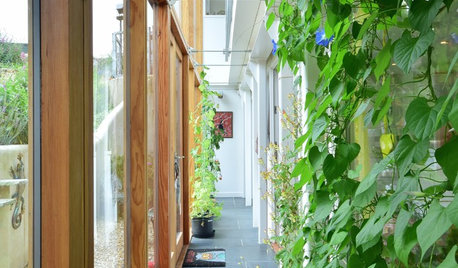Tips for healthy & organic living & indoor rooting & stuff that works
strawchicago z5
7 years ago
Featured Answer
Sort by:Oldest
Comments (28)
strawchicago z5
7 years agolast modified: 7 years agoRelated Discussions
Rooting some thai basil ; want to plant in custom organic mix
Comments (17)Dirt can have many meanings. The dirt in my area certainly is not loam but mostly clay. We have to really work to get loamy soil. Loam drains well, holds water and is loose, dark, and airy. Any ingredients should be free of disease. Dirt is not a good choice for potting mixes. Most professionals use a variation of the "Cornell Mix" Peat, perlite, vermiculite, lime. It is free of disease (sterile), drains well, holds water, and has plenty of air pockets. Sand makes the mix heavy so perlite is substituted where weight might be an issue. Leaf mould is more variable than peat ie the quality can be inconsistent from batch to batch. Composts in general can add its own problems as outlined in the link in my last post....See MorePlease, what in the world? Mushy branches and yet healthy roots.
Comments (9)I agree totally with jandey. I always water mine enough in the winter to keep the root balls from shrinking. For my 'garaged' plants, I usually check them about every two weeks. Since your plants are in warmth (what about light?), the chance of them rotting from water in the soil is a bit less. But to be on the safer side, when I water, I try to water around the perimeter of the pot rather than right at the base of the trunk. I would make sure they get some light - maybe add a cheapo flourescent if you don't already. Keep it at less than 8 hours. Last winter I watered too much and the garage got too cold for some plants (low 40s for prolonged periods), so I had some major rot on both stems and below the soil surface. This year I am watering a bit less and keeping the temps in the garage at between 53 deg. and 60 deg.F. They all look really good and some new inflos are starting to develop! 55 degrees seems to be a magic number for a lot of tropicals. It keeps them dormant, but they don't get overly cold. And bugs are not a problem. In the house where the temps are between 60 and 70, I don't worry quite as much about watering. I feel down about an inch into the soil. If it's bone dry, then I'll water a bit around the perimeter of the pot. Many of the indoor plumerias still have leaves and are pulling up water. Also, keep in mind that warm house areas are usually very low in humidity. Heck, even with our whole-house humidifier, I can't seem to get the humidity any higher than 40%. So that dryness will act to descicate the plants even more. In the South where they bare-root store them in garages, there are frequent warm-ups AND much higher humidity, which helps preserve the dormant plants, in my opinion....See Moregrowing indoor christmas cactus in CO tips?
Comments (46)Zach, I just saw you posted while I was replying to Liz and Mama! For me to even try to get useable pics I almost always have to move the plants to somewhere other than where they live. Because all of mine hang down below the bottom of the pot I just invert a bowl or “storage container” or something else “neutral” to sit them on while I take the pics, and then they get delivered back home! I also often try to take pics when the sun isn’t shinning (or close the drapes) which helps at least a little bit with “the white problem!” And, in my experience, flash is the worst thing you can do when trying to get a pic that actually looks like the color they are. They really are hard to get accurate pictures of them! But—if you have a BLACK one—I’d be interested!!! ;-) Since it’s so hard to tell from the pics exactly what the colors are, when yours gets big enough, I’d like to get a couple segments of your “salmon” one to—eventually—see how close or different they are. Whenever it works out! And if you have a lot of soil “without roots in it” in that planter, be sure you read all the “stuff” I just posted for Liz about Too Much Water. Until you can get them in smaller pots, be sure you’re letting them dry all the way, and stay dry for a while. Losing them is SAD! I learned that the hard way! Skybird...See MoreFive Months of Healthy Haworthia Roots
Comments (24)Breton - I'll see if seed suppliers here carry pots too, thanks for the tip. I bought those dollar store pots, but didn't take the plunge in using them yet either. Aztcqn - I've found the same, none of my three cymbiformis types go dormant either in the heat. They seem to pup rather well, so I'm sure yours will be more than back on track soon. Last fall I bought one nice ceramic bonsai pot that I haven't dared to use yet. It's a little shallow like yours, but not quite as wide. Once the weather gets nice enough outside, I'll definitely fill it up and experience the watering-difference. Those two emelyae x herbacea have a pretty cool pattern! Howard - Definitely will keep you in mind if my 'Crystal Ball' ever offsets. =) Wish I knew how old the STC reference 'Maruko' plant is. Right now it seems like quite some time away. At least I can see the distinctive leaf shape taking form though. 'Murasaki' appears quite dark unless light hits it at the right angle. It appears quite green inside the leaves, but on the outside the colour is more purplish. From what I've seen online, this is not unusual when they are small? Is this your observation as well? Really hoping by the end of spring it will start looking nice and interesting....See Morestrawchicago z5
7 years agolast modified: 7 years agostrawchicago z5
7 years agolast modified: 7 years agostrawchicago z5
7 years agolast modified: 7 years agostrawchicago z5
7 years agolast modified: 7 years agostrawchicago z5
7 years agolast modified: 7 years agostrawchicago z5
7 years agolast modified: 7 years agostrawchicago z5
7 years agolast modified: 7 years agostrawchicago z5
7 years agolast modified: 7 years agostrawchicago z5
7 years agolast modified: 7 years agostrawchicago z5
7 years agolast modified: 7 years agostrawchicago z5
7 years agolast modified: 7 years agostrawchicago z5
7 years agolast modified: 7 years agostrawchicago z5
7 years agolast modified: 7 years agostrawchicago z5
7 years agolast modified: 7 years agostrawchicago z5
7 years agolast modified: 7 years agostrawchicago z5
7 years agolast modified: 7 years agostrawchicago z5
7 years agolast modified: 7 years agostrawchicago z5
7 years agolast modified: 7 years agostrawchicago z5
7 years agostrawchicago z5
7 years agolast modified: 7 years agostrawchicago z5
7 years agolast modified: 7 years agostrawchicago z5
7 years agolast modified: 7 years agostrawchicago z5
7 years agolast modified: 7 years ago
Related Stories

HOUSEPLANTS8 Essentials for Healthy Indoor Plants
Houseplants add so much to our homes — and can thrive when grown in the right conditions. Keep these tips in mind
Full Story
ORGANIZING21 Tips for Organizing Your Stuff
Restore order at home with these ideas for tidying up cupboards, shelves, doors and more
Full Story
FEEL-GOOD HOMERejuvenate Your Home With Deep-Rooted Traditions
Give the subtle energies and spiritual side of your home some attention, and watch newfound calm and beauty blossom
Full Story
HOUZZ TOURSHouzz Tour: A Texas Home Gets a Healthy, Fresh Start
Mold eradication was just the beginning for this Austin family's home on a creek bed — toxins of all kinds now don't make it past the door
Full Story
HEALTHY HOME12 Ways to Set Up Your Kitchen for Healthy Eating
Making smart food choices is easier when your kitchen is part of your support team
Full Story
GARDENING GUIDESHow to Keep Your Citrus Trees Well Fed and Healthy
Ripe for some citrus fertilizer know-how? This mini guide will help your lemon, orange and grapefruit trees flourish
Full Story
GARDENING GUIDESHealthy Home: How to Go Green With a Living Wall or Roof
See 10 ways to add this earth-friendly element to your home
Full Story
LIFESlow Living 101: Tips for Turning Off the Chaos
It may feel as though you're too busy to slow down and enjoy life. But even little changes can have a big effect
Full Story
CONTAINER GARDENSFreshen Up the Bath With Lush and Healthy Plants
Learn how to choose and care for plants that will do well in your space
Full Story
FEEL-GOOD HOME10 Tips for a More Peaceful Home
Turn your everyday living space into a serene retreat by clearing visual distractions, softening your lighting and more
Full StorySponsored
More Discussions














Khalid Waleed (zone 9b Isb)